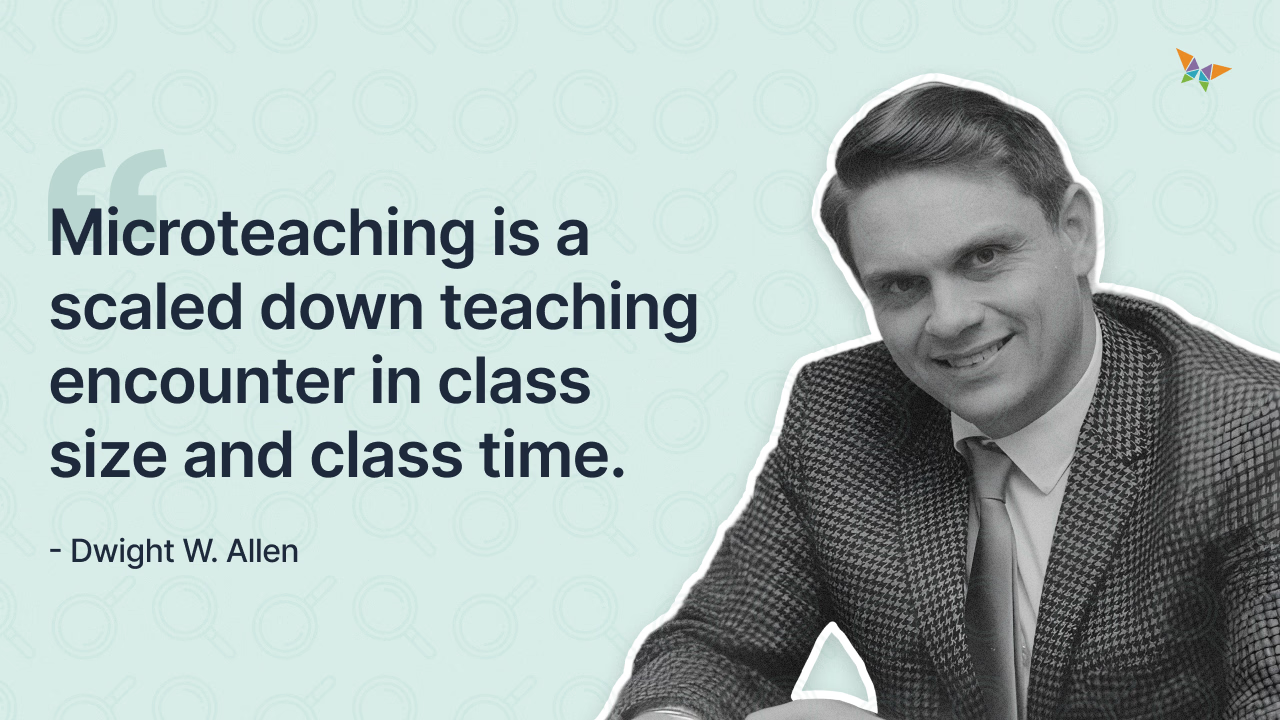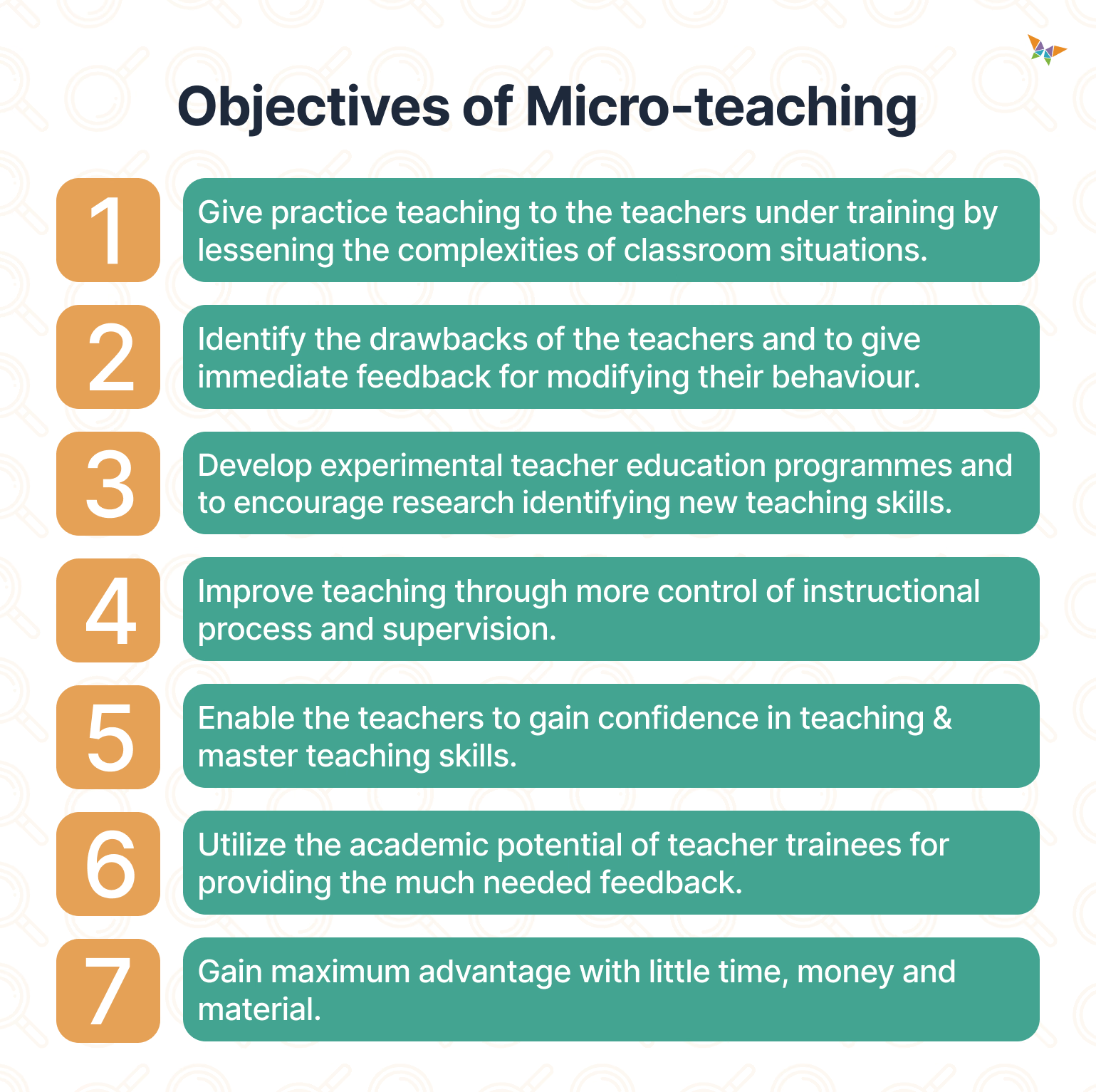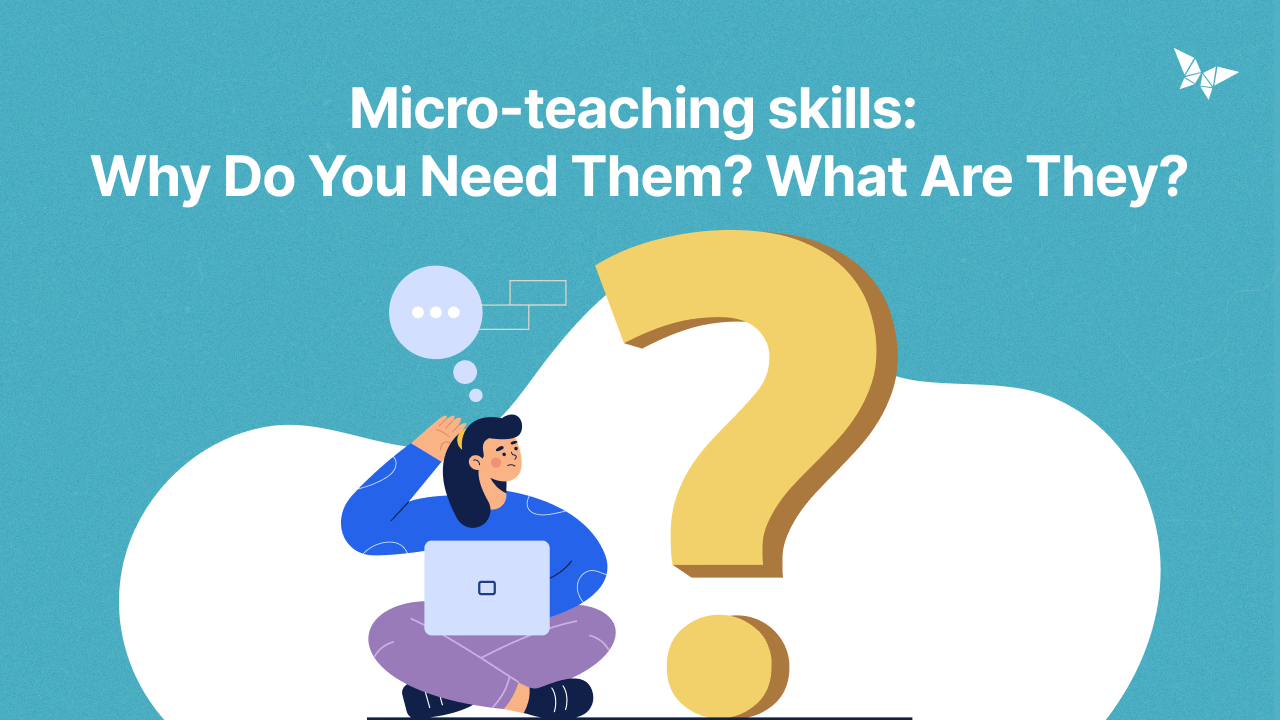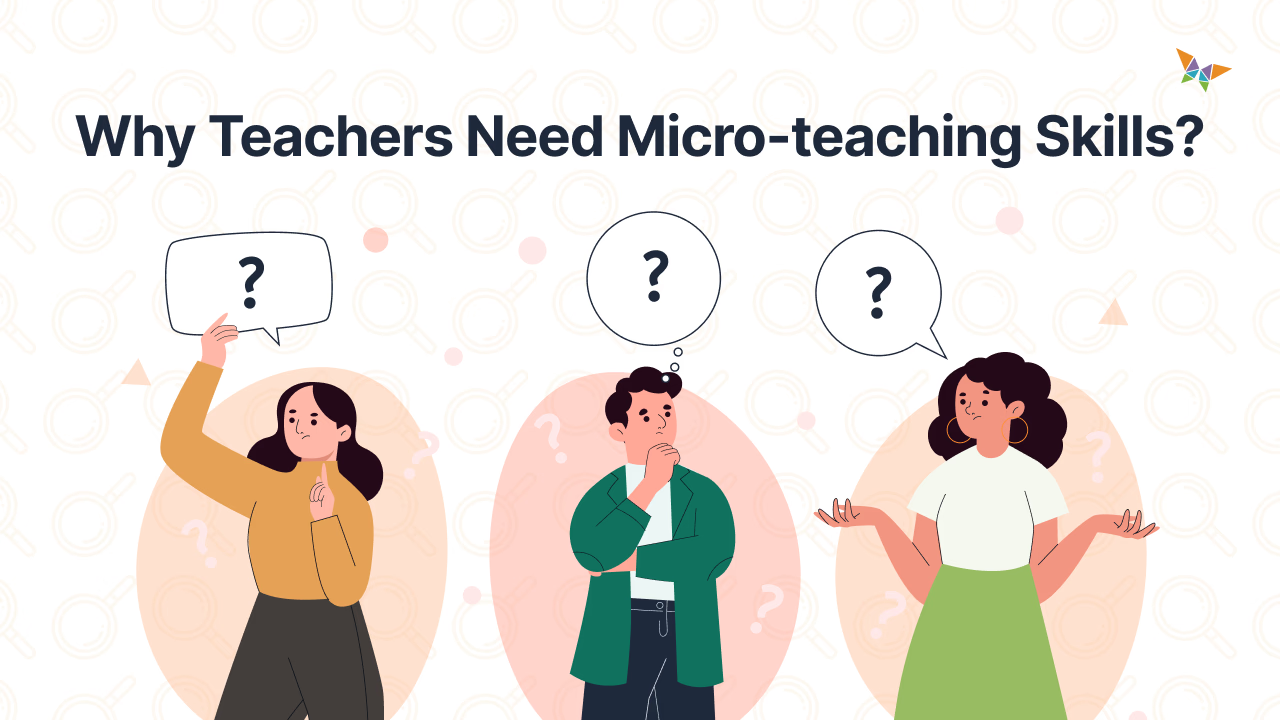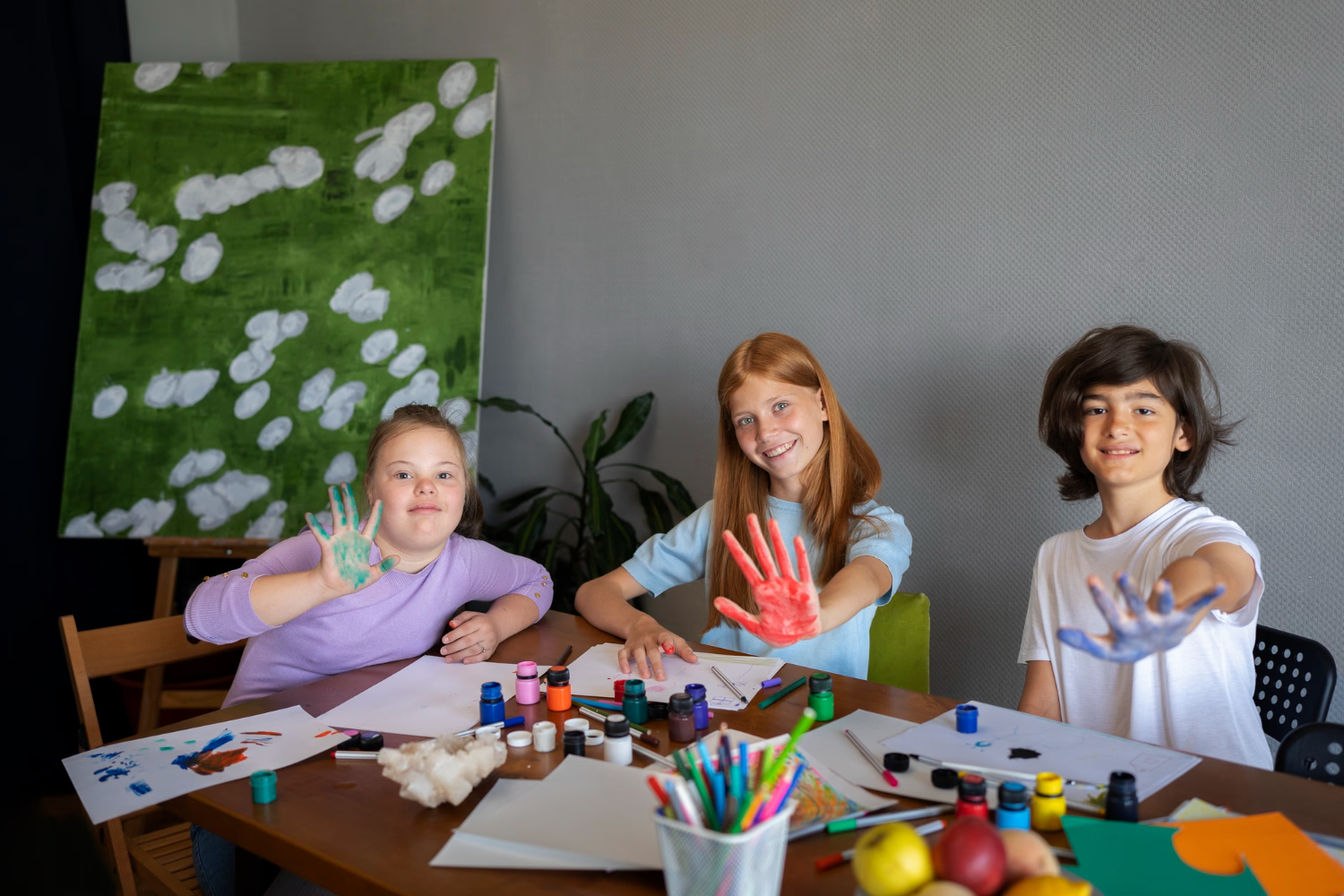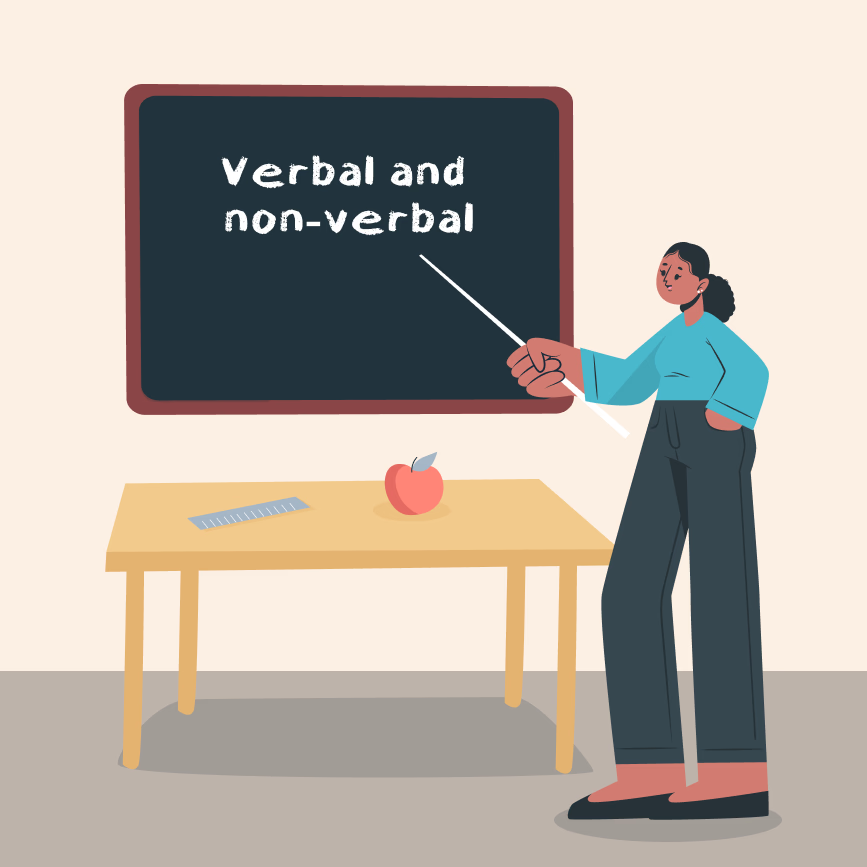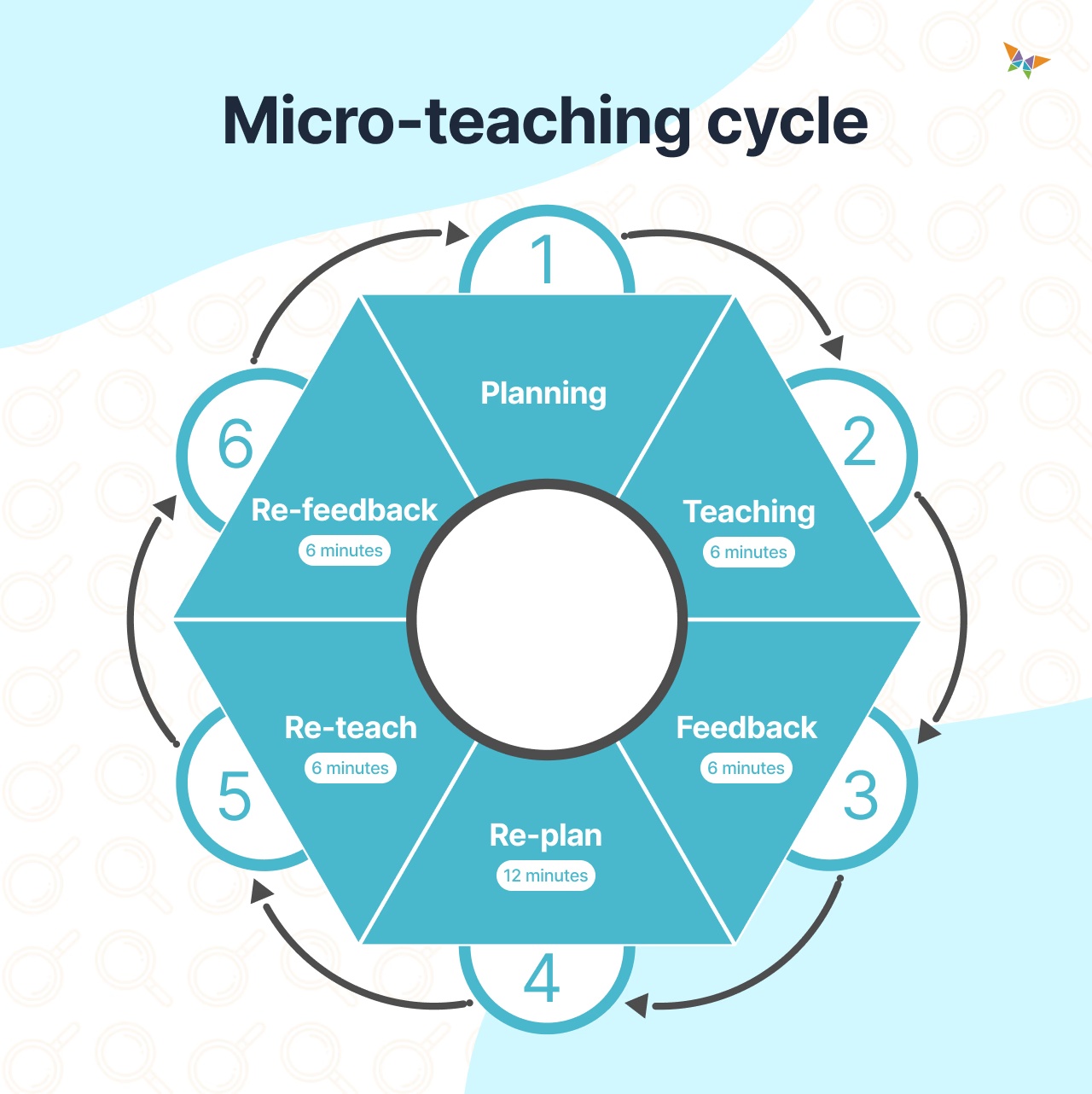MICRO TEACHING SKILLS - this term has gathered quite a lot of attention in recent times. But what is it? Why is it important? How can it help you improve your teaching skills? Well, if you, too, have been pondering these questions, then you are at the right place!
In this blog, we will talk about all things–micro-teaching. From what it is, why we need it, to what constitutes micro-teaching and the process of using it. So, without further ado, let’s begin.
According to Wikipedia, “Micro-teaching is a teacher training and faculty development technique whereby the teacher reviews a recording of a teaching session, in order to get constructive feedback from peers and/or students about what has worked and what improvements can be made to their teaching technique.”
Let’s break this down in simpler terms.
As you may already know, ‘micro’ means small. So, essentially, micro-teaching is a teaching situation where the time and number of learners are reduced (made small). This way, it becomes easier for you to understand better the techniques you employ and your colleagues or the observers to offer valuable feedback.
Microteaching is conducted to simulate a real-life teaching situation but in a controlled environment. This way, your peers or colleagues can observe all the nuances involved and identify the scope of improvement in your teaching methods.
What a nice approach to learn and grow, right? Now, let’s get to know the brain behind this impactful concept.
Micro-teaching was developed in 1963 by Dwight W. Allen at Stanford University. And, many years later after its development, a review was done to collect evidence for micro-teaching. And you will be surprised to know that it was found to be the sixth most effective method for improving student outcomes.
So, what can we achieve through micro-teaching? What are its objectives? Let’s find out.
Objectives of Micro-teaching
Wondering what are the core goals that make micro-teaching such an effective teaching approach? In this section, we'll delve into precisely that. Read along to understand the objectives of micro-teaching that make this one so impactful.
1. To provide practical training to new teachers in a controlled setup
Imagine you're learning to ride a bike. You don't start on a busy street, you begin in a safe, open space. Similarly, micro-teaching lets aspiring/new teachers practice in a controlled environment, making the complexities of the classroom more manageable.
This controlled practice allows them to build confidence and refine their teaching techniques. Additionally, it helps them develop their classroom management skills before stepping into a real classroom setting.
2. To identify the scope of improvement & get immediate feedback
Ever wish you could review and improve your teaching in real-time? Well, micro-teaching is the thing for you. It's like a coaching session. Here you identify the hiccups in your teaching style and get immediate feedback on how to smooth them out. Micro-teaching immediate feedback loop empowers you to address teaching challenges promptly, leading to continuous growth.
3. To develop experimental teacher programs & research
Micro-teaching is like a science lab. It's not just about teaching. It's about experimenting with different teaching methods. Micro-teaching encourages the creation of experimental teacher education programs, fostering a culture of continuous improvement and innovation.
4. To improve the teaching-learning process
Ever felt like teaching was a rollercoaster you couldn't steer? Micro-teaching hands you the reins. It's about gaining more control over the instructional method, like a maestro directing a symphony. This helps in fine-tuning teaching methods and enhancing the supervision of the observers.
This happens because the controlled set-up allows observers to closely examine your teaching techniques and interactions with students.
5. To enable teachers like you to gain confidence in teaching
Imagine conquering a challenging video game level. That sense of achievement? Micro-teaching provides that feeling for teachers. It's a confidence-building exercise where you can master various teaching skills on a smaller stage before facing the grand classroom.
6. To gain maximum advantage with little time, money & material
Micro-teaching is a cost-effective, time-efficient method. It's about gaining maximum advantage with minimal resources. This way, it is accessible to you at any stage of your career.
These objectives tell us the primary goal of micro-teaching. It is to provide a way for you to practice, refine, and perfect your teaching skills. Micro-teaching scales down the complexities of a full-sized classroom. It offers you a safe space to experiment and learn without the overwhelming pressure.
Another advantage of micro-teaching is that at its heart lies a commitment to teacher development. It's not merely about identifying flaws. It's about fostering a culture of continuous improvement, whether you’re a trainee teacher or an in-service one.
Learning Leap: Just like micro-teaching, Suraasa mentors provide a safe space for sharing your teaching challenges. Talk to a mentor for personalized guidance to advance in your teaching career. All aligned with your individual aspirations.
In essence, the objectives of micro-teaching extend far beyond the classroom walls. They are the building blocks of a dynamic, responsive, and ever-evolving teaching philosophy.
Well, by now, you must have gotten a fair idea about micro-teaching. Now, let's get on with understanding the skills that it encompasses and how it impacts us as teachers.
Micro-teaching skills refer to the specific teaching abilities and techniques that teachers gain/build during micro-teaching sessions. Basically, micro-teaching skills refer to a range of teaching competencies, including explaining, and demonstrating questioning, among others, that teachers learn while using the micro-teaching method.
It also covers instructional strategies, feedback, assessment, adaptability, time management, and reflective practices.
Micro-teaching isolates particular skills, such as questioning, explanation, or classroom management, providing you with a platform to practice and enhance these skills in a targeted manner. As a result, you are empowered through an intentional and reflective process to fine-tune your instructional methods and adapt to the diverse needs of your students.
Now. Let’s find out a little more about why you need to develop these micro-teaching skills.
Importance of Developing Micro-teaching Skills
Did you know that developing micro-teaching skills could have on your journey towards excellence in teaching? In this section, we will impact these skills of micro-teaching can have on the learning environment. We will also understand the multifaceted benefits they bring to both you and your students. So, let’s dive right in!
Micro-teaching skills are essential tools in your teaching toolkit. They're like those little adjustments you make to capture your students' attention. Have you noticed how a small change in your teaching style can light up the entire classroom? That's the power of micro-teaching skills at work. They help in making those changes that will just do the trick for you in your teaching.
You know how when you practice something, like a sport or an instrument, you get better at it? It's the same with teaching. When you really focus on improving specific skills, you improve each time. As a result, the whole classroom feels more alive and fun. It's like everyone's on the same team, working together towards the same goal.
Developing these skills is a journey of personal and professional growth for you as a teacher. They keep you adaptable and ready to tackle the ever-evolving challenges of teaching.
Now, let's think about the students. When you use micro-teaching skills, you make learning more accessible and enjoyable for them. Have you seen how students light up when they 'get' something? That's the magic of effective teaching through micro-teaching skills.
Isn't it fascinating how enhancing your teaching methods with micro-teaching skills can create a ripple effect? They benefit not just your students but also enrich your own teaching experience
Building upon this, let’s now understand why you need to pay attention to micro-teaching skills as a 21st-century teacher.
When we talk about modern teaching methods in 21st-century classrooms, micro-teaching skills become hard to ignore. So, naturally, the question is, what makes micro-teaching so relevant in today's educational landscape?
Well, the relevance of micro-teaching in contemporary educational practices lies in its adaptability. It's not a one-size-fits-all solution but rather a flexible framework that accommodates diverse teaching styles and learning needs. We live in an era where classrooms are increasingly diverse and dynamic.
Here, microteaching equips you with the tools to cater to individual learning styles. This way you can ensure that no student gets left behind.
The 21st-century classroom is more than just a space for delivering information. It's a hub for cultivating critical thinking, fostering creativity, and nurturing a passion for lifelong learning. Micro-teaching aligns perfectly with these goals, emphasizing not only what you teach but how you teach it. In this fast-paced educational environment, micro-teaching becomes a valuable ally for you to stay ahead of the curve.
The significance of micro-teaching skills lies in their direct contribution to effective teaching practices. It helps you gain self-awareness as a teacher. This self-awareness, coupled with feedback from peers and mentors, forms a foundation for professional growth. As we know, effective teaching is not a one-size-fits-all approach.
It requires a nuanced understanding of pedagogical techniques and the ability to adapt them to different learning environments. Skills of micro-teaching, by virtue of their targeted nature, help you to tailor your instructional approaches, ultimately enhancing their overall effectiveness in the classroom.
Let’s now delve into the specifics of skills of micro-teaching that empower you to create such enriching classrooms.
In the world of micro-teaching, you are presented with a diverse array of skills to refine and master. Each skill contributes to the holistic development of effective teaching practices. In this section, we will look into nine crucial skills of micro-teaching, with examples and tips for improvement.
1. Micro-Teaching Skill of Questioning
Effective questioning is a cornerstone of engaging teaching. As our writer Aashita puts it, teaching without asking the right kind of questions is similar to “constructing a building without the essential support pillars, resulting in an unstable foundation.”
Effective questioning skills involve the art of posing thought-provoking questions that stimulate critical thinking and active participation among students.
Examples: Open-ended inquiries like "How do you think this concept applies in real-life situations?" or "Can you propose alternative solutions to this problem?"
Tips for Improvement: Be alert and know when to ask questions to your students. Make sure to ask them in between the lessons instead of waiting for the lesson to complete.
Vary the types of questions posed (closed-ended, open-ended, probing) to encourage different levels of thinking. Pay attention to the pacing of your questions and allow sufficient time for students to formulate thoughtful responses.
2. Micro-Teaching Skill of Explaining
The skill of explaining entails the ability to articulate complex concepts in a clear, concise, and accessible manner, ensuring students grasp the content.
Examples: Teacher using analogies, and visual aids. For example, charts, diagrams and other audio or visual aids. This helps students understand complex or abstract concepts by relating them to familiar ideas.
Tips for Improvement: Share personal stories related to the topic to pique students' interest. Also, don’t forget to gather timely feedback by asking questions like, "Did that make sense to everyone? If not, can you tell me what you found confusing?".
3. Micro-Teaching Skill of Probing
Probing involves asking follow-up questions to deepen student understanding and encourage critical thinking. It seeks to explore the depth of knowledge and provoke thoughtful responses.
Examples: After a student provides an initial answer, a probing question might be, "Can you elaborate further on your reasoning?" or "How do you think this concept connects to what we discussed earlier?"
Tips for Improvement: Develop a repertoire of probing questions that challenge students to analyze and synthesize information. Practice active listening to tailor your probing questions based on students' responses.
4. Micro-Teaching Skill of Demonstrating
The micro-teaching skill of demonstrating is more like a 'show and tell' for teaching. It involves explaining and illustrating concepts, ideas, principles, laws, or teaching points by using specimens, devices, or experiments during the teaching-learning process. It's a method that brings the subject matter to life by showcasing real-world examples or practical applications in front of the students.
Examples: Roleplays, field trips, demonstrating using live experiments are all examples of demonstrations.
Tips for Improvement: Use a variety of demonstration techniques to cater to different learning styles. For example, combine visual demonstrations with hands-on activities or simulations. Show enthusiasm and passion for the subject matter during your demonstration. Your enthusiasm can inspire student interest.
5. Micro-Teaching Skill of Stimulus Variation
Stimulus variation involves diversifying instructional methods and materials to maintain student engagement. It recognizes that different learners respond to various stimuli.
Examples: Incorporate a mix of lectures, group activities, multimedia presentations, and class discussions. This way, you can cater to diverse learning preferences.
Tips for Improvement: Try and experiment with different teaching strategies and assess their impact on student engagement. Keenly observe students' reactions and adjust your approach accordingly.
6. Micro-Teaching Skill of Reinforcement
The micro-teaching skill of reinforcement falls under the realm of learning psychology. As we know, reinforcement is a technique that actively shapes the responses and behaviors of learners. It's like giving a thumbs-up to encourage positive behaviors or correct responses. This helps create a friendly and positive learning atmosphere.
The skill of reinforcement can be seen as teachers skillfully using reinforcers to guide students' behavior in the right direction. Here, the goal is to get everyone involved and achieve better results in the teaching-learning process.
Examples: Praise students for thoughtful contributions, provide encouragement during challenging tasks, and acknowledge improvement and effort.
Tips for Improvement: Be specific in your reinforcement, linking praise to specific behaviors or achievements. Be mindful to maintain a balance between positive reinforcement and constructive feedback for a well-rounded approach.
7. Micro-Teaching Skill of Illustrating with Examples
Illustrations, in the context of teaching, refer to the use of specific instances or examples. These are used to clarify and explain abstract or complex concepts. It involves providing real-world scenarios, visuals, or tangible cases that help students better understand and relate to the topic being discussed.
The skill of illustrating with examples is a powerful tool in a teacher's arsenal. It bridges the gap between the known and the unknown, making learning more relatable and engaging. This skill helps you to drive your students to analyze, synthesize, or apply knowledge creatively. As a result, you are able to foster critical thinking.
As a teacher, there are two kinds of illustrations that you may frequently use- verbal and non-verbal. Verbal illustrations involve using spoken or written descriptions, anecdotes, or explanations to clarify a concept. You can use verbal illustrations to provide context or offer analogies that make abstract ideas more comprehensible.
Non-verbal illustrations encompass the use of gestures, body language, visuals, and physical objects to convey meaning. These illustrations can be particularly effective for students who are visual or kinesthetic learners.
Such illustrations transcend language barriers. They can be powerful tools for conveying complex information and fostering a deeper level of understanding among students.
Examples: A history or an English teacher may go for illustrations like pictures and maps. While a science teacher may opt for live experiments or other visual aids to explain the concept in discussion.
Tips for Improvement: Consider the backgrounds and interests of your students when selecting examples. Encourage students to come up with their own examples to enhance their understanding.
8. Micro-Teaching Skill of Group Management
Group management is a critical skill in the practice of micro-teaching. It involves effectively and efficiently overseeing a small group of students during a teaching session.
This skill is essential for maintaining a conducive learning environment and maximizing student engagement. It is also crucial in achieving the desired learning outcomes. Successful group management ensures that students stay on task, interact productively, and participate actively in the classroom.
Examples: Implement clear expectations for group work, assign roles, and establish guidelines for respectful communication within the group.
Tips for Improvement: Practice proactive classroom management strategies, and address conflicts or disruptions promptly. Foster a sense of community within the group to enhance collaboration.
9. Micro-Teaching Skill of Blackboard/Whiteboard Writing
The skill of blackboard or whiteboard writing is a fundamental aspect of effective teaching. It involves the clear and organized presentation of information on the board, making it visually accessible to students.
This skill encompasses several key components that contribute to its effectiveness:
- Legibility: The teacher's handwriting must be clear and easily readable by all students in the classroom. Illegible writing can lead to confusion and hinder the learning process.
- Size and Alignment: Proper size and alignment of text and diagrams are crucial. Text should be large enough to be seen from all corners of the classroom, and alignment should be consistent to maintain visual clarity.
- Highlighting the Main Points: Effective blackboard writing involves emphasizing key points or important information. This could be achieved through underlining, bolding, or using a different color for emphasis. Highlighting helps students identify critical content.
- Utilization of the Space: Efficient use of the board space is essential. Teachers should avoid overcrowding or leaving too much blank space, as both can be distracting.
- Blackboard/whiteboard Summary: Summarizing key points or concepts on the board can help students grasp the main takeaways from the lesson.
- Correctness: Accuracy in what is written on the board is paramount. Errors or inaccuracies can lead to confusion and erode students' trust in the teacher's expertise. So, make sure to give a quick glance at what you’ve written before moving on with the explanation.
- Position of the Teacher: Your position while writing on the board is essential. So, try standing to the side of the board, not blocking the view for students. Use your body language to engage with the class while writing.
- Contact with the Student: Maintaining eye contact and verbal interaction with students while writing on the board fosters engagement. Remember to periodically turn to the class, explain the content verbally, and ask questions to gauge understanding.
Examples: Use consistent formatting, such as bullet points or diagrams, to enhance clarity. Prioritize key concepts and avoid overcrowding the board with information.
Tips for Improvement: Practice legible and organized writing. Periodically pause to ensure students have enough time to copy information. Utilize different colors or highlighters to emphasize important details.
Alright, now that you know so much about the nine essential micro-teaching skills, you must be very excited to know how to use them practically for maximum results in your classroom. Well, let’s explore that in the following section.
In this section, let’s take a step further & bridge the gap between theory and practice. This will ensure you are able to confidently implement micro-teaching techniques in real-world teaching scenarios. So, let’s, delve into the practical application of micro-teaching skills:
Using the Micro Teaching Cycle in the Classroom
Imagine you have a toolkit designed specifically to enhance your teaching skills in a focused and efficient manner. That's exactly what the micro-teaching cycle is—a structured yet flexible approach to improving teaching methods.
Let's break down how this cycle operates in an ideal classroom setting.
- Planning: Prepare a short lesson of not more than 15 minutes.
- Teaching (6 minutes): The cycle begins with a brief, concentrated teaching session. In these 6 minutes, you focus on delivering a specific skill or concept. It's all about clarity and precision here.
- Feedback (6 minutes): Right after teaching, you receive immediate feedback. This 6-minute period is crucial for understanding the effectiveness of your teaching and areas for improvement.
- Re-plan (12 minutes): Reflecting on the feedback, you spend the next 12 minutes re-planning your approach. This is where you modify your teaching strategy, making it more tailored and effective.
- Re-teach (6 minutes): With your refined plan, you teach again for another 6 minutes. This is your opportunity to put into practice the improvements you've ideated.
- Re-feedback (6 minutes): Finally, you receive another round of feedback. This last 6-minute session helps you gauge the impact of the adjustments you've made.
Integrating Micro Teaching Skills into Lesson Plans
Now, let's talk about integrating these micro-teaching skills into your lesson plans. This is where creativity meets methodology.
Step 1: Identify Your Focus Area
Start by pinpointing the specific skill or concept you want to enhance or teach.
Step 2: Design a Micro Lesson Plan
Tailor a short, 6-minute micro lesson plan focusing solely on that area.
Note: A micro lesson plan is nothing but a miniature version of a regular lesson plan. It typically includes all of the same elements of a regular lesson plan but on a smaller scale.
Step 3: Plan for Feedback
Decide how you will gather feedback—whether it's from a peer, mentor, or even a recording of your session.
Step 4: Incorporate Flexibility for Re-planning
Ensure your lesson plan has room for modifications post-feedback.
Step 5: Execute and Reflect
Teach, receive feedback, and then re-teach. Reflect on the changes and their impact.
Excited to try it out? Here is a detailed step-by-step guide for implementing micro-teaching skills into your lesson plans.
This guide will serve as a practical roadmap, ensuring you can seamlessly integrate these techniques into your teaching practice.
Objective: Assume that you want to teach the basic concepts of the four seasons and their characteristics.
Lesson Plan:
- Duration: A concise, 6-minute interactive session.
- Content: Use visual aids like charts or video clips to depict the characteristics of each season (spring, summer, autumn, winter), highlighting key changes in weather, nature, and activities associated with each.
- Methodology: Incorporate a mix of storytelling and questioning to engage students. Use images or real-world examples to make the concept relatable.
Feedback Focus:
- Aspects for Feedback: Clarity of content delivery, effectiveness of visual aids, and engagement level of students.
- Feedback Method: Peer observation and student feedback through quick, anonymous response cards.
First Teaching Session:
- Implementation: Deliver the lesson focusing on the vivid description of each season, using visual aids.
- Observation: Have a colleague observe the session and take notes, especially on student reactions and engagement.
Feedback Collection and Analysis:
- Immediate Reflection: Self-assess your clarity and pacing.
- Feedback Review: Discuss with your observer and read student feedback, focusing on areas of improvement.
Re-planning for Re-teaching:
- Adjustments: Based on feedback, plan to include more interactive elements like asking students to share their favorite season and why.
- Time Allocation: Spend around 12 minutes revising the plan, ensuring these elements are well-integrated.
Re-teaching Session:
- Second Implementation: Teach the lesson again with the added interactive elements.
- Adjustment Focus: Pay attention to how these changes affect student engagement and understanding.
Second Round of Feedback:
- Collection: Gather feedback again, focusing on the effectiveness of the new interactive elements.
- Evaluation: Assess if the interactive approach led to better engagement and understanding.
Final Reflection and Documentation:
- Reflect: Reflect on the overall effectiveness of both sessions, noting improvements and areas for further enhancement.
- Document: Record your experiences, feedback, and reflections for future reference.
In this scenario, you're not just teaching the concept of seasons but also engaging students actively, making the learning process more dynamic and memorable. The key takeaway is the importance of adaptability and responsiveness to feedback in enhancing the learning experience.
As we conclude our exploration of micro-teaching, we recognize its transformative power in shaping modern education. Emerging from Stanford University's innovative practices, micro-teaching has evolved into a fundamental strategy for elevating teaching standards and enriching student learning experiences.
Throughout this journey, we've delved into the heart of micro-teaching, revealing how it deconstructs the intricate art of teaching into manageable components, thereby promoting a culture of continuous growth and excellence.
As this article comes to a close, consider the insights and strategies shared here as a resource for your professional toolkit. We would like to encourage you to employ them in your teaching.
Armed with the information and tips here, we are confident that you are ready to embark on this adventure and witness the wonders you can unfold in your classroom.
Happy (micro) teaching!
Want to equip yourself with the best international teaching practices? Book a one-to-one session with a Suraasa mentor and get started right away!




.avif)

